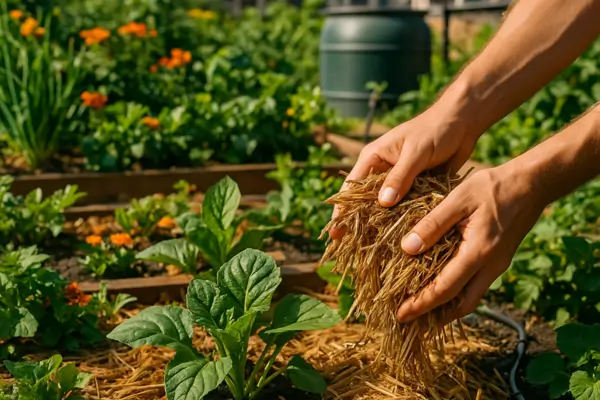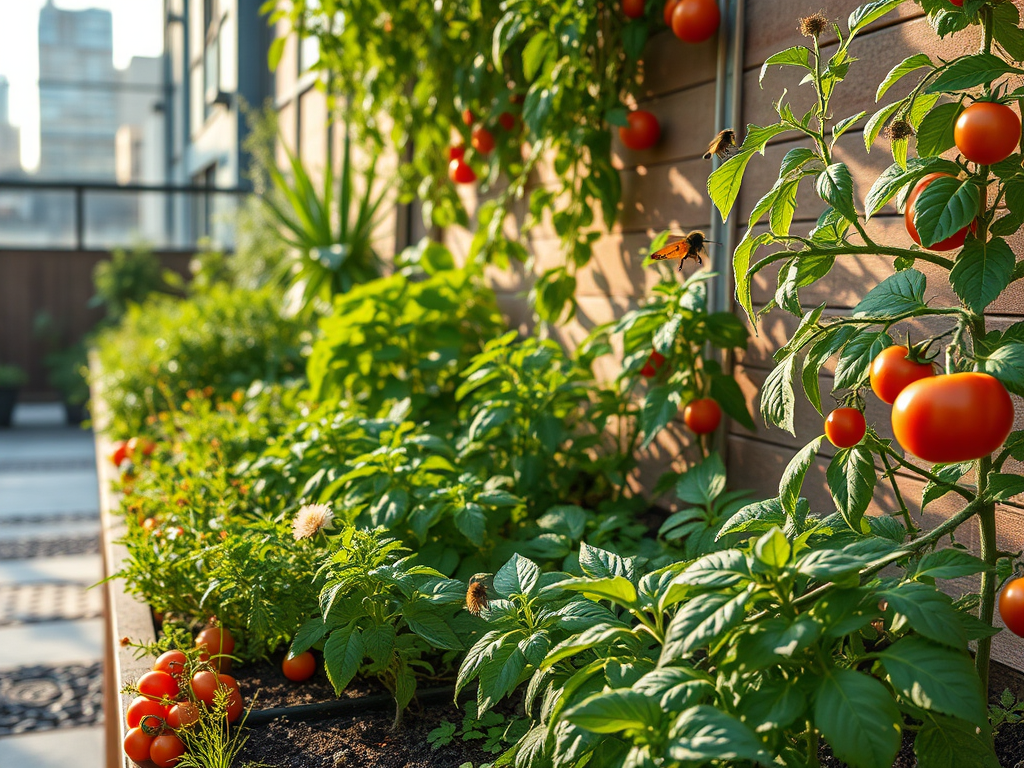In the heart of bustling cities, where concrete often overshadows greenery, urban permaculture offers a sustainable solution to grow food, conserve resources, and restore ecological balance. This innovative approach adapts traditional permaculture principles—working with nature rather than against it—to fit small spaces like balconies, rooftops, and community gardens. Among its many benefits, urban permaculture improves soil health, increases biodiversity, and reduces waste—all while producing fresh, local food.
One of the biggest challenges in urban gardening is water conservation. Cities face increasing water scarcity due to climate change, population growth, and inefficient water use. Traditional landscaping and agriculture often waste water through runoff and evaporation, but urban permaculture provides smarter solutions. By implementing water-wise techniques, city dwellers can maintain thriving gardens while minimizing their environmental impact.
A simple yet highly effective method for reducing water waste is mulching. Mulch—a protective layer of organic or inorganic material spread over soil—helps retain moisture, suppress weeds, and regulate soil temperature. Whether you’re growing herbs on a windowsill or managing a community garden plot, mulching can drastically cut water usage while boosting plant health.
In this article, we’ll explore how urban permaculture and mulching techniques work together to conserve water, along with practical tips to implement them in your own green space. Let’s dig in!
Key Takeaways:
✔ Urban permaculture brings sustainable gardening to cities, improving food security and ecosystems.
✔ Water conservation is crucial in urban areas due to scarcity and inefficient usage.
✔ Mulching is a simple, cost-effective way to reduce water waste and enhance soil health.
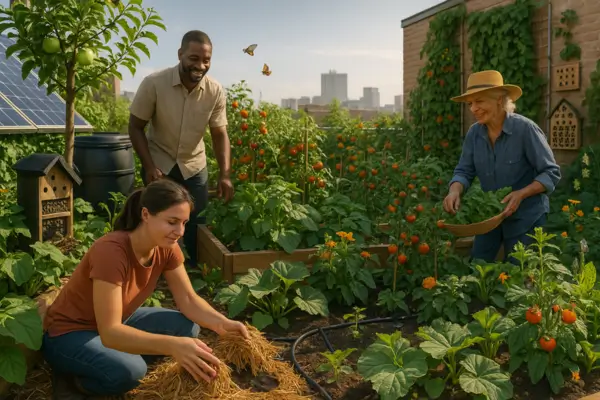
Understanding Urban Permaculture
Definition and Principles of Permaculture in an Urban Setting
Permaculture—a fusion of “permanent agriculture” and “permanent culture”—is a design philosophy that mimics natural ecosystems to create sustainable, self-sufficient environments. While traditionally applied to rural landscapes, urban permaculture adapts these principles to city living, transforming balconies, rooftops, vacant lots, and small yards into productive, regenerative spaces.
At its core, urban permaculture follows three ethical principles:
- Earth Care – Nurturing healthy soil, conserving water, and supporting biodiversity.
- People Care – Building community resilience through shared knowledge and local food production.
- Fair Share – Redistributing surplus resources and minimizing waste.
Key design principles include:
- Stacking Functions – Each element (like a rain barrel) serves multiple purposes (water collection, irrigation, and habitat for beneficial insects).
- Closing the Loop – Recycling organic waste into compost and reusing greywater.
- Working with Nature – Using companion planting, natural pest control, and passive water harvesting instead of chemical inputs.
How Urban Permaculture Differs from Traditional Gardening
While conventional urban gardening often focuses on aesthetics or isolated food production, urban permaculture integrates whole-system thinking. Here’s how it stands apart:
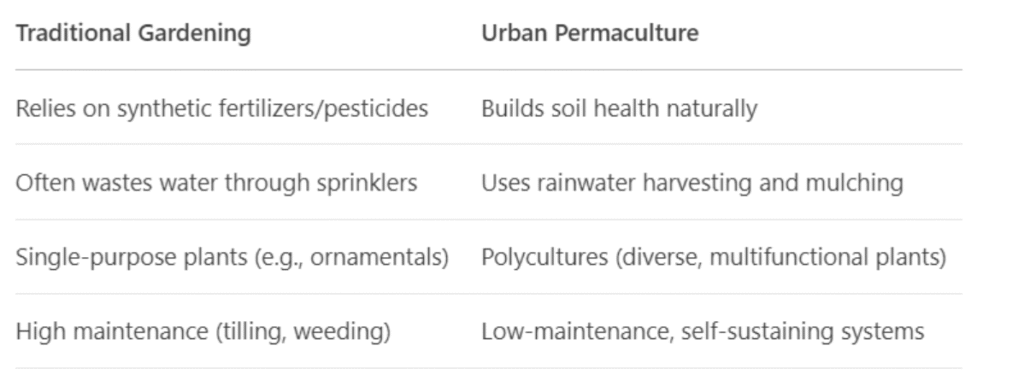
For example, instead of planting a lone ornamental tree, an urban permaculturist might choose a fruit tree surrounded by nitrogen-fixing plants, mulch to retain moisture, and a rain garden to capture runoff—all in one compact space.
The Role of Sustainable Water Management
In cities, where impermeable surfaces dominate, water often becomes a wasted resource or a flooding hazard. Urban permaculture addresses this by:
- Capturing Rainwater – Using barrels, swales, or green roofs to store water.
- Reducing Runoff – Planting deep-rooted perennials and using permeable paving.
- Prioritizing Efficiency – Drip irrigation, mulching, and drought-tolerant plants minimize water use.
By designing systems that slow, spread, and sink water into the landscape (a key permaculture mantra), urban growers can turn scarcity into abundance—even in the driest concrete jungles.
Key Takeaways:
✔ Urban permaculture applies ecological design to cities, focusing on sustainability and closed-loop systems.
✔ It goes beyond gardening by creating multifunctional, low-waste ecosystems.
✔ Smart water management is central—conserving every drop through harvesting, mulching, and efficient design.
Next, we’ll explore the pressing issue of urban water waste and how mulching offers a solution.
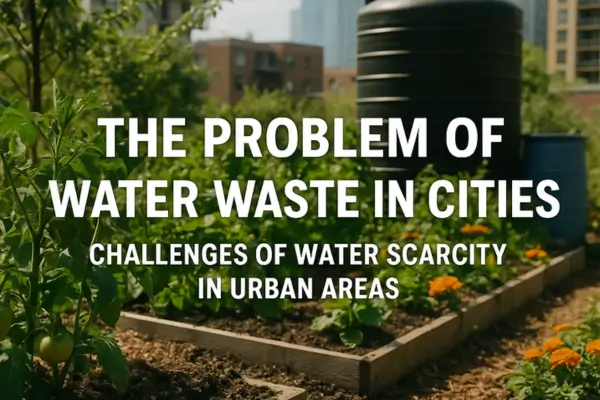
The Problem of Water Waste in Cities
Challenges of Water Scarcity in Urban Areas
Modern cities face a growing water crisis that threatens urban agriculture and green spaces. As populations swell and climate patterns shift, many metropolitan areas experience:
- Dwindling freshwater supplies due to over-extraction of groundwater and shrinking reservoirs
- Increased water demand from growing populations and urban heat island effects
- Aging infrastructure that loses up to 30% of treated water through leaks (EPA estimates)
- Unequal access where marginalized communities often face the worst shortages
The UN predicts that by 2030, global water demand will outstrip supply by 40%. Urban growers feel this acutely when watering restrictions hit during droughts – just when plants need hydration most.
Common Sources of Water Waste in Urban Gardens
Well-intentioned gardeners often unknowingly waste precious water through:
- Surface Runoff: Water flowing off compacted soil before plants can absorb it
- Evaporation Loss: Up to 70% of sprinkler water evaporates before reaching roots (USGS data)
- Overwatering: The average homeowner uses 2-4 times more water than plants require
- Poor Timing: Daytime watering loses more to evaporation than early morning irrigation
- Bare Soil Exposure: Unmulched gardens lose 10-25% more water to evaporation
Even efficient-looking drip systems can waste water if not properly maintained, with leaks often going unnoticed until plants show stress.
Why Traditional Irrigation Methods Fall Short
Conventional watering approaches developed for rural farms often fail in urban settings:
Sprinkler Systems:
- Lose up to 50% of water to wind and evaporation
- Wet leaves instead of roots, promoting disease
- Often water sidewalks and driveways as much as plants
Hose Watering:
- Leads to inconsistent soil moisture
- Encourages shallow root systems
- Requires daily attention during heat waves
Automated Timers:
- Don’t adjust for rainfall or seasonal needs
- Can run during rainstorms if not moisture-sensor equipped
- Promote “set it and forget it” wastefulness
The good news? Urban permaculture offers smarter solutions. In the next section, we’ll explore how mulching revolutionizes water conservation by working with natural systems rather than against them.
Key Takeaways:
✔ Urban water scarcity worsens due to climate change, population growth, and infrastructure issues
✔ Common gardening practices waste more water than they deliver to plants
✔ Traditional irrigation methods designed for rural contexts fail in water-stressed cities
✔ Solutions exist in nature-inspired approaches like mulching (coming next)
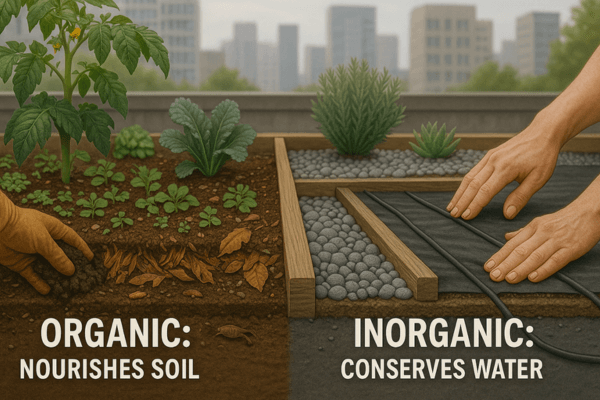
What is Mulching? Nature’s Water-Saving Superpower
Definition and Types of Mulch
Mulching is the practice of applying a protective layer over soil to mimic nature’s own ground cover. In forests, fallen leaves and decaying plants naturally mulch the earth—urban permaculture simply accelerates this process. Mulch comes in two main categories:
Organic Mulches (Living & Breathing)
- Plant-Based: Straw, leaves, grass clippings, wood chips, bark
- Food Waste: Compost, cocoa hulls, spent coffee grounds
- Living Mulch: Low-growing plants like clover or creeping thyme
Best for: Improving soil fertility, regulating temperature, and supporting microbial life
Inorganic Mulches (Long-Lasting Barriers)
- Mineral: Gravel, pebbles, volcanic rock
- Synthetic: Rubber chips, landscape fabric, black plastic
Best for: Permanent pathways, extreme drought conditions, or areas needing weed suppression without soil improvement
Pro Tip: In urban permaculture, we prioritize organic mulches because they decompose to feed the soil—transforming waste into wealth.
The Triple Benefits of Mulching
1. Water Retention (The Thirst Quencher)
A 3-inch layer of organic mulch can:
- Reduce evaporation by up to 70% (USDA Agricultural Research Service)
- Cut watering needs by 30-50%
- Protect soil from sun and wind erosion
2. Soil Health (The Underground Revolution)
Mulch acts as a slow-release fertilizer by:
- Feeding earthworms and beneficial fungi
- Balancing soil pH naturally
- Preventing compaction from heavy rains
3. Weed Suppression (The Gentle Warrior)
Mulch blocks sunlight from weed seeds while:
- Eliminating the need for chemical herbicides
- Reducing garden maintenance time
- Creating a “clean” look without artificial interventions
How Mulching Embodies Permaculture Principles
Mulching is permaculture in action—it exemplifies three core ideals:
1. “Observe & Interact”
By noticing how nature mulches itself (like forest floors), we replicate the system.
2. “Produce No Waste”
Yard trimmings, fallen leaves, and food scraps become valuable mulch instead of landfill fodder.
3. “Integrate Rather Than Segregate”
Mulch connects water, soil, and plants into one cooperative system—just as permaculture intends.
Real-World Example:
A Brooklyn rooftop garden uses coffee grounds from local cafes as mulch. This:
- Diverts waste from landfills
- Acidifies soil for blueberry bushes
- Attracts decomposer organisms
- Reduces watering frequency
Key Takeaways:
✔ Mulch mimics nature’s ground cover to protect and nourish soil
✔ Organic mulches improve ecosystems; inorganic suits specific needs
✔ It delivers the “holy trinity” of benefits: water savings, soil vitality, and weed control
✔ Perfectly aligns with permaculture’s closed-loop, waste-to-resource philosophy
Next up: The science behind how mulch dramatically cuts water waste—with surprising data from urban farms.
How Mulching Reduces Water Waste: The Science of Smart Irrigation
The Moisture-Locking Mechanism of Mulch
Mulch acts like a sponge and shield for your soil through three powerful mechanisms:
- Physical Barrier Effect
A 3-4 inch mulch layer creates a protective buffer between soil and air, slowing moisture escape. Studies show bare soil loses water 5 times faster than mulched soil during peak heat.
- Temperature Regulation
Mulch keeps soil up to 30°F cooler in summer (Cornell University research), dramatically reducing evaporation rates. Dark-colored mulches like compost are particularly effective at insulating soil.
- Capillary Action Disruption
Mulch breaks the “wicking” process where water moves upward through soil particles and evaporates. This is especially crucial in urban container gardens where edges accelerate drying.
By the Numbers: Mulch vs. Evaporation

Urban Heat Island Bonus: In cities where temperatures run 5-10°F hotter than surrounding areas, mulch becomes even more effective at conserving water compared to rural applications.
Urban Success Stories
1. Los Angeles Community Garden Project
- Challenge: Water restrictions limited irrigation to 2x/week
- Solution: Applied 4″ wood chip mulch to all beds
- Results:
✓ 45% reduction in water use
✓ Tomato yields increased 20%
✓ Eliminated weekend watering needs
2. Berlin Rooftop Farm
- Innovation: Used wool mulch from local textile waste
- Water Savings:
- 60% less irrigation than unmulched control beds
- Survived 2-week heatwave without plant loss
- Created new recycling stream for textile industry
3. Singapore Vertical Garden
- Breakthrough: Coconut coir mulch in hydroponic towers
- Findings:
- Extended watering cycles from 6 hours to 72 hours
- Reduced algal growth by 80%
- Improved air-root zone humidity
The Permaculture Perspective
These examples demonstrate how mulching delivers on permaculture’s “slow and small solutions” principle. A simple layer of organic material can:
✓ Turn water scarcity into water abundance
✓ Transform urban waste into valuable resources
✓ Create microclimates that defy city heat effects
Pro Tip: For maximum water retention, combine mulch with other permaculture techniques like swales (in ground gardens) or wicking beds (for containers).
Next: We’ll explore exactly which mulches work best for different urban growing situations – from balcony containers to community garden plots.
Best Mulching Techniques for Urban Permaculture
Choosing the Right Mulch for Your Urban Garden
Not all mulches are created equal—here’s how to match materials to your growing situation:
For Small Spaces & Containers:
- Coconut Coir: Lightweight, excellent moisture retention (lasts 2-3 years)
- Compost: Doubles as fertilizer (apply 1-2″ layer)
- Leaf Mold: Free resource from fall collections (shredded works best)
For Raised Beds & Community Gardens:
- Straw: Affordable, insulates well (watch for seed contamination)
- Wood Chips: Long-lasting (ideal for paths and perennial beds)
- Living Mulch: Clover or creeping thyme between crops
For Hot/Dry Climates:
- Grape Pomace: Byproduct from wineries (acidic, great for berries)
- Wool Pellets: Slow-release water absorbers (3x their weight)
- Mineral Mulches: Volcanic rock for permanent plantings
Pro Tip: Urban waste streams often provide free mulch—check with local tree services (wood chips), coffee shops (grounds), or newspapers (shredded for sheet mulching).
Proper Mulch Application for Water Retention
Follow this 4-step system for maximum effectiveness:
- Prep the Soil:
- Water deeply before applying mulch
- Remove weeds (or smother with cardboard first)
- For compacted soil, aerate with a fork
- Layer Smartly:
- 3-4″ depth for most organic mulches
- 1-2″ for fine materials like compost
- Leave 1″ space around plant stems
- Timing Matters:
- Apply after soil warms in spring
- Refresh in fall to protect overwintering roots
- Top up as mulch decomposes (usually annually)
- Special Cases:
- Containers: Use lighter mulch + water-retention crystals
- Slopes: Netting over straw prevents wash-off
- Wet Areas: Coarse wood chips improve drainage
Synergistic Water-Saving Systems
Multiply your savings by combining mulch with:
1. Drip Irrigation Under Mulch
- Buries tubing beneath mulch
- Reduces evaporation loss to <5%
- Example: A Tucson community garden cut water use 60% with this combo
2. Rainwater Harvesting
- Mulched beds absorb roof runoff 3x better
- “Mulch basins” around trees capture rain
- Brooklyn rooftop project stores 500gal + mulch = no municipal water for herbs
3. Wicking Beds
- Mulch top layer over water reservoir
- Eliminates surface evaporation
- Perfect for balcony gardens
4. Hugelkultur Mounds
- Woody debris base + mulch topping
- Acts like a sponge during droughts
- Seattle urban farm grew veggies with just rainfall using this method
Case Study: A San Francisco apartment complex combined:
✓ Recycled arborist wood chips
✓ Drip irrigation on timers
✓ Rain barrels from roof runoff
Result: 75% less water used for landscaping
Next Up: We’ll dive into creative small-space mulching solutions—including how to mulch vertical gardens and indoor planters.
Practical Tips for Implementing Mulching in Small Spaces
Space-Specific Mulching Strategies
Container Gardens (Balcony/Patio)
- Lightweight Layers: Use coconut coir or shredded bark (avoids heavy wet soil)
- Living Mulch: Plant microclover or moss between containers
- Self-Wicking Pots: Place 1″ gravel mulch above water reservoir
- Pro Tip: Coffee filter under mulch prevents soil loss through drainage holes
Raised Beds (Community Gardens/Rooftops)
- Lasagna Mulching: Alternate newspaper, compost, and straw layers
- Edge Protection: Use larger wood chips around bed borders
- Seasonal Rotation: Straw in summer for cooling, leaves in winter for insulation
- Pro Tip: Bury food-grade 5-gallon buckets with holes as underground watering reservoirs beneath mulch
Vertical Gardens (Walls/Pallets)
- Felt Mulch: Recycled wool blankets behind planting pockets
- Moss Matrix: Sphagnum moss retains moisture in tower gardens
- Hydroponic Mulch: Clay pebbles in NFT systems
- Pro Tip: Use mulch tea bags (nylon stockings filled with compost) in vertical planters
DIY Urban Mulch Sources
Turn waste into water-saving gold with these ideas:
- Paper/Cardboard: Shredded office paper or pizza boxes (remove tape)
- Textile Waste: Old cotton clothes cut into strips
- Brewery Byproducts: Spent grain from local craft beer makers
- Aquarium Waste: Used aquatic plants (rich in nutrients)
- Pet Supplies: Cleaned fur from dog brushes or hamster bedding
- Grocery Resources: Banana peels (dried and chopped) or egg cartons
Safety Note: Avoid glossy papers, walnut hulls (allelopathic), or grass clippings with pesticide residue
10 Common Mulching Mistakes to Avoid
- Volcano Mulching
Piling against tree trunks → rot and pests
Fix: Keep 3″ clear around stems
- Thin Application
Less than 2″ → weeds breakthrough
*Fix: Maintain 3-4″ depth*
- Wrong Material Choice
Using fresh wood chips on annuals → nitrogen theft
Fix: Pre-compost or use aged chips
- Neglecting Decomposition
Not refreshing mulch → turns hydrophobic
Fix: Top up annually
- Rain Blocking
Compacted mulch repels water
Fix: Fluff with fork periodically
- Pest Hotels
Thick mulch near house foundations
Fix: Use gravel in 12″ perimeter
- Moisture Imbalance
Mulching wet soil → fungal issues
Fix: Let soil dry slightly first
- Uniform Layers
Same depth everywhere → poor air flow
Fix: Taper thickness at edges
- Ignoring Soil Tests
Acidic mulch on alkaline-loving plants
Fix: Match mulch pH to crops
- Overmulching Seedlings
Smothers new growth
Fix: Wait until plants are 4″ tall
Urban Hack: The Mulch Battery System
Create a moisture reservoir in small spaces:
- Bury a perforated plastic bottle in container
- Fill with absorbent mulch (wool or coir)
- Top with decorative mulch
- Water through the bottle neck
*Extends watering intervals by 3-5 days*
Case Study: A Tokyo balcony gardener grew 15 herbs year-round using this system with shredded newspaper mulch, reducing watering to just weekly.
Next: We’ll explore how to adapt these techniques for different climate challenges – from humid cities to arid environments.
Mulching for Different Urban Growing Systems
Balcony & Rooftop Gardens: Sky-High Mulching Solutions
Lightweight Mulch Options
- Cork Mulch
- Made from recycled wine stoppers
- Floats during heavy rain (prevents container overflow)
- Lasts 5+ years without breaking down
- Hemp Hulls
- 30% more absorbent than coir
- Naturally pest-resistant
- Available as byproduct from CBD production
- Moss Sheets
- Pre-grown on biodegradable netting
- Adds instant green coverage
- Reduces wind evaporation by 40%
Moisture Retention Hacks
- Pocket Mulching: Place water-retentive mulch only over root zones
- Mulch Blankets: Reusable geotextile mats with mulch pockets
- Self-Watering Mulch: Mix water-storing crystals into decorative mulch
Case Study: A Chicago rooftop gardener combined cork mulch with ollas (clay pots) to grow tomatoes with only weekly watering – even in 90°F heat.
Community Gardens: Collective Mulching Strategies
Coordinating Shared Spaces
- Material Bulk Buying
- Pool resources for truckload wood chip deliveries
- Split costs of commercial compost
- Skill-Sharing Workshops
- Host “Mulch Mondays” for communal application
- Create demonstration plots showing different techniques
- Waste Stream Partnerships
- Partner with local coffee shops for grounds
- Arrange leaf collection from neighborhood streets
Conflict Prevention Tips
- Establish clear mulch depth guidelines
- Designate areas for different mulch types
- Create a “mulch library” with labeled bins
Success Story: A Portland community garden reduced water bills by 60% after implementing coordinated straw mulching and rainwater harvesting.
Indoor & Hydroponic Systems: Mulch Adaptations
Controlled Environment Solutions
- Clay Pebble Mulch
- For hydroponic systems
- Reflects light up to lower leaves
- Prevents algae growth
- Biochar Topping
- 1/4″ layer on houseplant soil
- Filters air while retaining moisture
- Lasts indefinitely
- Smart Mulch Mats
- Fabric with moisture sensors
- Changes color when watering needed
- Integrated with app notifications
DIY Indoor Mulches
- Terra Cotta Chips: Broken pot pieces as decorative mulch
- Mushroom Substrate: Spent growing medium for orchids
- Moss Poles: Living mulch for climbing plants
Innovation Spotlight: Singapore vertical farms use aeroponic misting combined with wool mulch pads to achieve 95% water savings compared to traditional farming.
System Comparison Chart
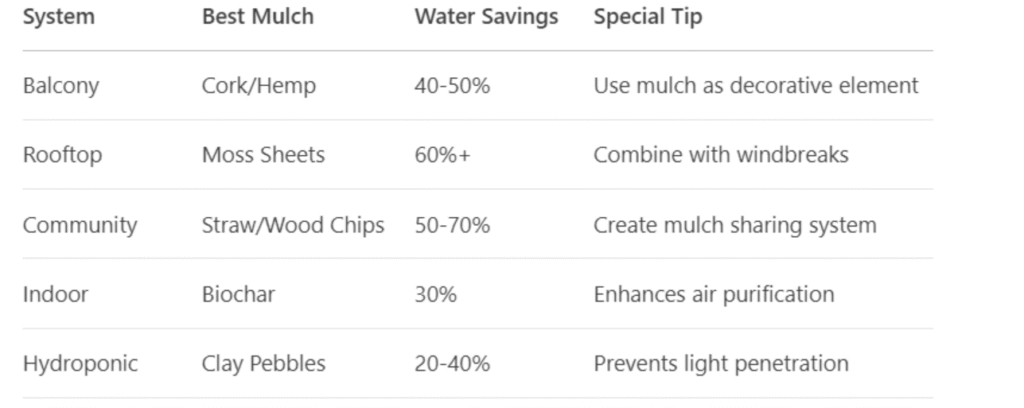
Pro Tip: In all systems, always leave slight breathing room around plant stems to prevent rot – the “mulch donut” method works universally.
Next: We’ll examine the science behind why these techniques work so effectively in urban environments.
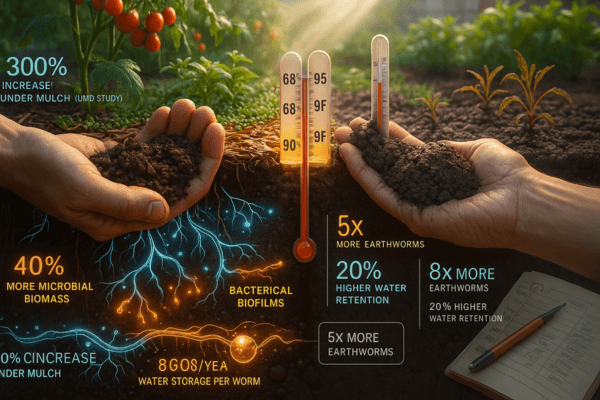
The Science Behind Mulching & Water Conservation
Soil Microbiology: The Hidden Water Regulators
Mulch doesn’t just cover soil—it transforms the underground ecosystem:
- Fungal Networks
- Mycorrhizal fungi increase 300% under organic mulch (University of Maryland study)
- These “living pipelines” extend root reach for water access
- Produce glomalin—a protein that improves soil structure
- Bacterial Balance
- Mulched soils maintain 40% higher microbial biomass
- Actinobacteria populations (responsible for soil “fresh rain” smell) thrive
- Create biofilms that act as microscopic water reservoirs
- Earthworm Activity
- Mulched areas host 5x more earthworms
- Each worm creates 8 gallons of water-holding channels annually
- Castings increase water retention by 20%
Microclimate Effect: A 3″ mulch layer can maintain 68°F soil temps when air temperatures reach 95°F—protecting microbial life during heat waves.
Documented Water Savings: Research Findings
Key Studies

Mechanisms of Action
- Capillary Break
Mulch disrupts the soil’s natural wicking action that brings water to the surface to evaporate
- Vapor Barrier
Reduces evaporative loss equivalent to 1″ rainfall per week in arid climates
- Hydraulic Lift
Some plants (like comfrey) transfer water from deep soil to mulch layer at night
Urban Specific Finding: Mulched street trees in NYC required 35% less irrigation while growing 40% faster than unmulched counterparts (NYC Parks Dept 5-year study).
Long-Term Urban Soil Transformations
Drought Resistance Timeline
Year 1:
- 25-40% water use reduction
- Surface crusting eliminated
Year 3:
- Water infiltration rate doubles
- Organic matter increases 1.5%
Year 5+:
- Forms drought-resistant “sponge soil”
- Survives 3-week dry spells without irrigation
- Develops natural water storage layers
Carbon Sequestration Bonus
Well-mulched urban soils can sequester:
- 1 ton CO2/acre/year in temperate climates
- Up to 3 tons in tropical cities
(Data: Rodale Institute Urban Carbon Project)
Case Example: A Detroit urban farm’s mulched plots now absorb 8″ of rainfall per hour versus 1/2″ in adjacent unmulched lots—transforming flood zones into productive land.
The Physics of Mulch Protection
- Albedo Effect
Light-colored mulches reflect solar radiation, reducing surface temps up to 18°F
- Boundary Layer Creation
Mulch forms a 2-3mm still air buffer that slows evaporation
- Hysteresis Control
Maintains ideal matric potential (-10 to -33 kPa) for plant water uptake
Pro Tip: The “sweet spot” for urban mulch depth follows the 1:3 ratio—1″ of mulch for every 3″ of plant height.
Next: We’ll explore how to combine these scientific principles into real-world urban applications.
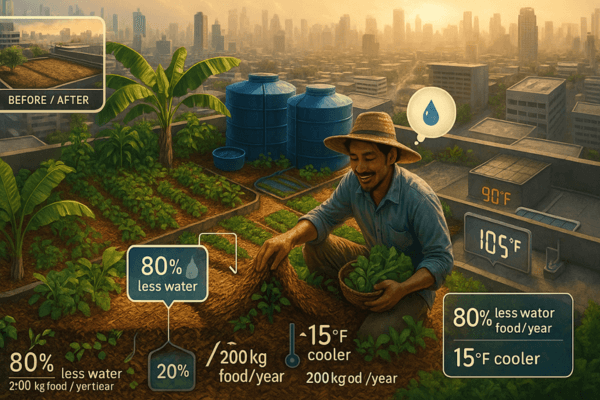
Success Stories: Urban Permaculture & Mulching in Action
Global Case Studies of Water-Wise Transformation
1. The Concrete Oasis: Bangkok Rooftop Farm
Challenge: 105°F heat waves with water rationing
Solution:
- Installed coconut husk mulch + wicking bed system
- Created microclimate with banana circle mulch basins
Results:
✓ 80% reduction in irrigation needs
✓ Grows 200kg of food annually on 40m²
✓ Reduced rooftop temps by 15°F
“We went from daily watering to just monsoon-season self-sufficiency.”
— Somchai R., Urban Farmer
2. Desert Abundance: Phoenix Community Garden
Challenge: Only 8″ annual rainfall
Innovation:
- Recycled glass mulch (tumbled) around drought-tolerant plants
- Hugelkultur mounds with deep wood chip mulch
Outcomes:
✓ Zero municipal water use for native plant zones
✓ 50% longer growing season
✓ Became neighborhood cooling hub
“The mulch keeps our soil at 80°F when pavement hits 140°F.”
— Maria G., Garden Coordinator
3. Vertical Revolution: Singapore High-Rise Farm
Breakthrough:
- Aeroponic towers with wool mulch pads
- Living wall systems using moss mulch matrix
Impact:
✓ 95% less water than conventional farming
✓ Supplies 10% of building’s salad greens
✓ Won 2023 Urban Innovation Award
Practitioner Spotlights
The Balcony Innovator (Toronto, Canada)
“I use wine corks chopped into chunks as mulch for my container herbs. They float during heavy rains, preventing soil loss through drainage holes. My watering dropped from daily to twice weekly!”
— Lila K., Apartment Gardener (@TinyLeafFarm)
The Community Leader (Cape Town, South Africa)
“During Day Zero water crisis, our mulched gardens were the only productive plots. We trained 300 households in sheet mulching—it literally saved our urban food system.”
— Thomas N., Permaculture Designer
The Rooftop Pioneer (Brooklyn, USA)
*”Our secret? Coffee ground mulch from local cafes. It’s free, deters slugs, and cuts our irrigation bill by $1,200/year on just 1,000 sq ft.”*
— Jamal R., Eagle Street Rooftop Farm
By the Numbers: Mulching Impact

Lessons from the Field
- Waste = Resource
Every city’s “trash” holds mulch potential—from Chicago’s brewery grains to Tokyo’s shredded office paper
- Small Scale, Big Impact
Even 1cm of mulch in window boxes creates measurable differences
- Community Multiplier Effect
Each trained urban gardener influences an average of 8 neighbors (USDA Extension data)
Turning Water Scarcity into Abundance Through Mulching
Why Mulching Works for Urban Permaculture
From balconies to rooftops, community gardens to hydroponic setups, mulching has proven to be one of the most effective ways to conserve water in cities. By now, you’ve seen how:
✔ Mulch acts like a sponge, reducing evaporation by up to 70% and cutting irrigation needs in half.
✔ It transforms waste into wealth, turning leaves, wood chips, coffee grounds, and even shredded paper into valuable soil protectors.
✔ Healthy soil biology thrives under mulch, creating drought-resistant ecosystems that require less human intervention.
✔ Urban growers worldwide are succeeding—whether in Phoenix’s extreme heat or Singapore’s high-rises—by using smart mulching strategies.
Start Small, Think Big
You don’t need a farm to make an impact. Even a single potted plant benefits from mulch. Here’s how to begin:
- Pick Your Mulch – Start with what’s free (leaves, grass clippings, cardboard).
- Apply It Right – 2-4 inches deep, keeping it away from stems.
- Observe & Adapt – Notice how much longer soil stays moist.
Pro Tip: Try the “finger test” – if soil under mulch is still damp after a week, you’re winning!
Join the Movement
🌱 Have you tried mulching in your urban garden? Share your wins (or challenges!) in the comments.
🌿 Questions? Ask away—our community of permaculture enthusiasts loves to help.
🌎 Tag #UrbanMulchRevolution to show off your water-wise garden!
Every layer of mulch is a step toward a cooler, greener, more resilient city. Let’s grow the change—one patch at a time.

